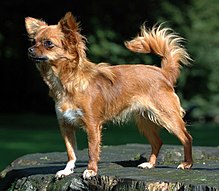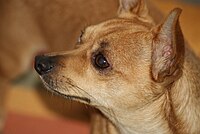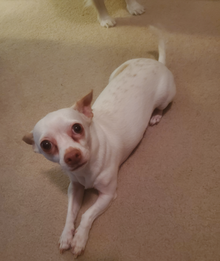How Often Do You Feed a 9 Week Old Baby Chihuahua Puppy
| Chihuahua | |||||||||||||||||||||||||||||
|---|---|---|---|---|---|---|---|---|---|---|---|---|---|---|---|---|---|---|---|---|---|---|---|---|---|---|---|---|---|
 | |||||||||||||||||||||||||||||
| Origin | United mexican states | ||||||||||||||||||||||||||||
| |||||||||||||||||||||||||||||
| |||||||||||||||||||||||||||||
| Dog (domestic domestic dog) | |||||||||||||||||||||||||||||
The Chihuahua (;[ane] Spanish: chihuahueño) is ane of the smallest breeds of dog,[2] and is named later on the Mexican land of Chihuahua.
History [edit]
Chihuahuas remained a rarity until the early 20th century, and the American Kennel Club did non register a Chihuahua until 1904.[3] In a 1520 letter, Hernan Cortés wrote that the Aztecs raised and sold the piffling dogs as food.[four] Colonial records refer to small, nearly hairless dogs at the beginning of the 19th century, 1 of which claims 16th-century conquistadores found them plentiful in the region afterward known as Chihuahua.[five]
Genetic lineage [edit]
An analysis of DNA from the genome of domesticated dogs indicates that they entered North America from Siberia for 4,500 years and were then isolated for the next 9,000 years. After contact with Europeans, these lineages were replaced by Eurasian dogs and their local descendants. The pre-contact dogs exhibited a unique genetic signature that is now almost gone.[six] In 2020, the sequencing of aboriginal domestic dog genomes indicates that in two Mexican breeds the Chihuahua retains 4% and the Xoloitzcuintli 3% pre-colonial ancestry.[7]
Appearance [edit]
Chihuahuas are the smallest brood recognized past some kennel clubs.[8]

A shorthair deer-caput Chihuahua's head

A shorthair apple-caput Chihuahua, showing pronounced stop
Current brood standards defined by registries specify an "apple-head" or "apple-dome" skull conformation.[nine] Chihuahuas have large, round eyes and large, cock ears, prepare in a loftier, dramatically rounded skull.[8] The stop is well defined, forming a most-xc-degree angle where the muzzle meets the skull.[ten] Dogs of the older "deer" type, with a flat-topped caput, more widely set eyes, larger ears, and longer, more slender legs, may withal exist registered.[ix] [x]
Breed standards for this dog practice not more often than not specify a peak; simply a weight and a description of their overall proportions. Generally, the height ranges between 6 and 9 in (15 and 23 cm);[8] notwithstanding, some dogs grow equally tall as 30 to 38 cm (12 to 15 in). Both British and American breed standards state that a Chihuahua must non weigh more than 5.9 lb (2.7 kg) for conformation.[viii]
Withal, the British standard also states that a weight of 4–vi lb (i.viii–2.7 kg) is preferred. A clause stating "if two dogs are equally proficient in type, the more than atomic one is preferred" was removed in 2009.[11] The Fédération Cynologique Internationale standard calls for dogs ideally between ane.5 and 3.0 kg (3.iii and 6.six lbs), although smaller ones are adequate in the show ring.[12]
Pet Chihuahuas (those bred or purchased equally companions rather than as show dogs) often range above these weights, even higher up 10 lb (4.v kg), if they have large os structures or are allowed to become overweight.[8] This does not mean that they are not purebred Chihuahuas; they just do non run into the requirements to enter a conformation show. Oversized Chihuahuas are seen in some of the best, and worst, bloodlines. Chihuahuas do not breed true for size, and puppies from the same litter can mature in drastically unlike sizes from one another. Besides, larger breeding females are less likely to experience dystocia (obstructed labour). Many breeders try to breed Chihuahuas to be every bit small-scale as possible, because those marketed every bit "teacup" or "tiny teacup" need college prices.[13]
Chihuahuas occur in almost any color combination, from solid to marked or splashed.[14]
The Fédération Cynologique Internationale, which represents the major kennel clubs of 84 countries, disqualified the merle coat pattern, which appears mottled.[12] In May 2007, The Kennel Order decided non to annals puppies with this coloration due to the health risks associated with the responsible gene, and in December of that year, formally amended its breed standard to disqualify merle dogs.[15]
Like many other small dogs, the Chihuahua may display to a higher place-average aggression towards people and other dogs.[xvi] [17]
Health [edit]
The Chihuahua has some predisposition to several neurological diseases, amidst them atlantoaxial instability, ceroid lipofuscinosis, congenital deafness, congenital hydrocephalus, muscular dystrophy, necrotizing meningoencephalitis and neuroaxonal dystrophy.[xviii] : 3 [nineteen] In a radiographical study of canine periodontal affliction in 2001, the Chihuahua was found to have the everyman incidence of whatever of the six breeds studied.[20] : 206 [21] : 532

A chihuahua with a carpal valgus deformity in the left forelimb
Chihuahuas may suffer from patellar luxation.[22] Their lifespan is betwixt 12–15 years, just it is possible for them to alive past 20.
Run into also [edit]
- Dogs portal
- List of dog breeds
- Companion dog
- Dogs in Mesoamerica
- Toy Group
References [edit]
- ^ Wells, John (April 3, 2008). Longman Pronunciation Lexicon (tertiary ed.). Pearson Longman. ISBN978-1-4058-8118-0.
- ^ "The 25 Smallest Dog Breeds". American Kennel Club. Retrieved January 26, 2021.
- ^ Coile, C. (2013). Chihuahuas: Everything almost purchase, care, diet, behavior, and preparation. Hauppauge, NY: Barron's Educational Series, p. 7: "Only in 1904 did the American Kennel Club (AKC) register its offset Chihuahua; a total of v were registered that year."
- ^ "Hernan Cortés: from Second Letter to Charles 5, 1520". Fordham University. Retrieved March 25, 2014.
- ^ Pedro Baptista Pino y Juan Lopez Cancelada, Exposición sucinta y sencilla de la Provincia del Nuevo México y otros escritos. Ed. Jesus Paniagua Perez. Valladolid: Junta de Castilla / León: Universidad de León, 2007, p. 244: "fifty-fifty in the desert the tiny dogs could be found, hunting rats, mice, and lizards." The footnote that follows alludes to starving Conquistadores reportedly hunting and stewing the dogs (Universidad Veracruzana, Arquivo Viejo, XXVI.2711).
- ^ Ní Leathlobhair, Máire; et al. (July half-dozen, 2018). "The evolutionary history of dogs in the Americas". Scientific discipline. 361 (6397): 81–85. Bibcode:2018Sci...361...81N. doi:10.1126/science.aao4776. PMC7116273. PMID 29976825. S2CID 206663458.
- ^ Bergström, Anders; et al. (2020). "Origins and genetic legacy of prehistoric dogs". Science. 370 (6516): 557–564. doi:ten.1126/science.aba9572. PMC7116352. PMID 33122379. S2CID 225956269.
- ^ a b c d e Charlotte Wilcox (April 1, 1999). "Quick Facts". The Chihuahua. Capstone. pp. 4–5. ISBN978-0-7368-0158-4 . Retrieved March ane, 2013.
- ^ a b Walker, Joan Hustace (2006). The Everything Chihuahua Book: A Consummate Guide to Raising, Preparation, And Caring for Your Chihuahua. Adams Media. pp. 16–eighteen. ISBN9781440523687 . Retrieved June 15, 2019.
- ^ a b "Official Standard of the Chihuahua" (PDF) . Retrieved November 12, 2019.
- ^ "The Kennel Club". thekennelclub.org.uk. Archived from the original on Oct xxx, 2017. Retrieved October 17, 2013.
- ^ a b "Chihuahua standard" (PDF). Fédération Cynologique Internationale. July 28, 2009. Retrieved October 25, 2011.
- ^ Segovia, Stacey Smith (March 21, 2004). "Runt of the litter". The Leaf Chronicle. ProQuest 441596979.
- ^ American Kennel Club Chihuahua page, retrieved on July 29, 2007.
- ^ "Kennel Club breed standard". Thekennelclub.org.britain. May xv, 2006. Archived from the original on January 3, 2009. Retrieved August 14, 2009.
- ^ Deborah 50. Duffy, Yuying Hsu, James A. Serpell (2008). Brood differences in canine aggression. Practical Animal Behaviour Science. 114 (3–4, December 2008): 441–460. doi:ten.1016/j.applanim.2008.04.006. (subscription required).
- ^ Paul D. McGreevy, Dana Georgevsky, Johanna Carrasco, Michael Valenzuela, Deborah L. Duffy, James A. Serpell (December 2013). Dog Beliefs Co-Varies with Height, Bodyweight and Skull Shape. PlosOne. doi:10.1371/journal.pone.0080529.
- ^ Curtis Westward. Dewey, Ronaldo C. Da Costa (2016). Signalment and History: The First Considerations. In: Curtis W. Dewey, Ronaldo C. Da Costa (2016). Practical Guide to Canine and Feline Neurology, third edition. Ames, Iowa; Chichester, West Sussex; Oxford: Wiley Blackwell. ISBN 9781119946113, pages 1–8.
- ^ Chihuahua (long and smoothen coat): Hydrocephalus. Genetic Welfare Problems of Companion Animals. Wheathampstead, Hertfordshire: The International Animal Welfare Science Gild/Universities Federation for Animal Welfare. Accessed February 2021.
- ^ V. Butković, M. Šimpraga, M. Šehić, et al. (2001) Dental diseases of dogs: a retrospective report of radiological data. Acta Veterinaria Brno. 70: 203–208.
- ^ C. Wallis, L. J. Holcombe (2020). A review of the frequency and impact of periodontal affliction in dogs. Journal of Pocket-size Animal Practice. 61: 529–540. doi:10.1111/jsap.13218.
- ^ https://akcchf.org/educational-resource/library/manufactures/articles/chihuahuaupdate0410.pdf[ bare URL PDF ]
External links [edit]
-
 Media related to Chihuahua (dog) at Wikimedia Eatables
Media related to Chihuahua (dog) at Wikimedia Eatables
Source: https://en.wikipedia.org/wiki/Chihuahua_(dog)
0 Response to "How Often Do You Feed a 9 Week Old Baby Chihuahua Puppy"
Post a Comment